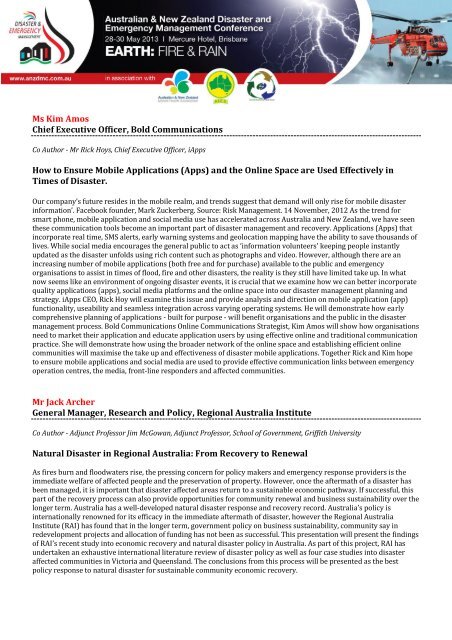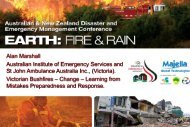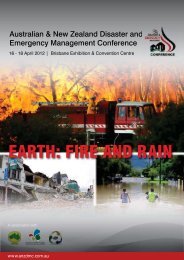Book of Abstracts 2013 - Australian and New Zealand Disaster ...
Book of Abstracts 2013 - Australian and New Zealand Disaster ...
Book of Abstracts 2013 - Australian and New Zealand Disaster ...
You also want an ePaper? Increase the reach of your titles
YUMPU automatically turns print PDFs into web optimized ePapers that Google loves.
Ms Kim Amos<br />
Chief Executive Officer, Bold Communications<br />
Co Author - Mr Rick Hoys, Chief Executive Officer, iApps<br />
How to Ensure Mobile Applications (Apps) <strong>and</strong> the Online Space are Used Effectively in<br />
Times <strong>of</strong> <strong>Disaster</strong>.<br />
Our company’s future resides in the mobile realm, <strong>and</strong> trends suggest that dem<strong>and</strong> will only rise for mobile disaster<br />
information’. Facebook founder, Mark Zuckerberg. Source: Risk Management. 14 November, 2012 As the trend for<br />
smart phone, mobile application <strong>and</strong> social media use has accelerated across Australia <strong>and</strong> <strong>New</strong> Zeal<strong>and</strong>, we have seen<br />
these communication tools become an important part <strong>of</strong> disaster management <strong>and</strong> recovery. Applications (Apps) that<br />
incorporate real time, SMS alerts, early warning systems <strong>and</strong> geolocation mapping have the ability to save thous<strong>and</strong>s <strong>of</strong><br />
lives. While social media encourages the general public to act as ‘information volunteers’ keeping people instantly<br />
updated as the disaster unfolds using rich content such as photographs <strong>and</strong> video. However, although there are an<br />
increasing number <strong>of</strong> mobile applications (both free <strong>and</strong> for purchase) available to the public <strong>and</strong> emergency<br />
organisations to assist in times <strong>of</strong> flood, fire <strong>and</strong> other disasters, the reality is they still have limited take up. In what<br />
now seems like an environment <strong>of</strong> ongoing disaster events, it is crucial that we examine how we can better incorporate<br />
quality applications (apps), social media platforms <strong>and</strong> the online space into our disaster management planning <strong>and</strong><br />
strategy. iApps CEO, Rick Hoy will examine this issue <strong>and</strong> provide analysis <strong>and</strong> direction on mobile application (app)<br />
functionality, useability <strong>and</strong> seamless integration across varying operating systems. He will demonstrate how early<br />
comprehensive planning <strong>of</strong> applications - built for purpose - will benefit organisations <strong>and</strong> the public in the disaster<br />
management process. Bold Communications Online Communications Strategist, Kim Amos will show how organisations<br />
need to market their application <strong>and</strong> educate application users by using effective online <strong>and</strong> traditional communication<br />
practice. She will demonstrate how using the broader network <strong>of</strong> the online space <strong>and</strong> establishing efficient online<br />
communities will maximise the take up <strong>and</strong> effectiveness <strong>of</strong> disaster mobile applications. Together Rick <strong>and</strong> Kim hope<br />
to ensure mobile applications <strong>and</strong> social media are used to provide effective communication links between emergency<br />
operation centres, the media, front-line responders <strong>and</strong> affected communities.<br />
Mr Jack Archer<br />
General Manager, Research <strong>and</strong> Policy, Regional Australia Institute<br />
Co Author - Adjunct Pr<strong>of</strong>essor Jim McGowan, Adjunct Pr<strong>of</strong>essor, School <strong>of</strong> Government, Griffith University<br />
Natural <strong>Disaster</strong> in Regional Australia: From Recovery to Renewal<br />
As fires burn <strong>and</strong> floodwaters rise, the pressing concern for policy makers <strong>and</strong> emergency response providers is the<br />
immediate welfare <strong>of</strong> affected people <strong>and</strong> the preservation <strong>of</strong> property. However, once the aftermath <strong>of</strong> a disaster has<br />
been managed, it is important that disaster affected areas return to a sustainable economic pathway. If successful, this<br />
part <strong>of</strong> the recovery process can also provide opportunities for community renewal <strong>and</strong> business sustainability over the<br />
longer term. Australia has a well-developed natural disaster response <strong>and</strong> recovery record. Australia’s policy is<br />
internationally renowned for its efficacy in the immediate aftermath <strong>of</strong> disaster, however the Regional Australia<br />
Institute (RAI) has found that in the longer term, government policy on business sustainability, community say in<br />
redevelopment projects <strong>and</strong> allocation <strong>of</strong> funding has not been as successful. This presentation will present the findings<br />
<strong>of</strong> RAI’s recent study into economic recovery <strong>and</strong> natural disaster policy in Australia. As part <strong>of</strong> this project, RAI has<br />
undertaken an exhaustive international literature review <strong>of</strong> disaster policy as well as four case studies into disaster<br />
affected communities in Victoria <strong>and</strong> Queensl<strong>and</strong>. The conclusions from this process will be presented as the best<br />
policy response to natural disaster for sustainable community economic recovery.






